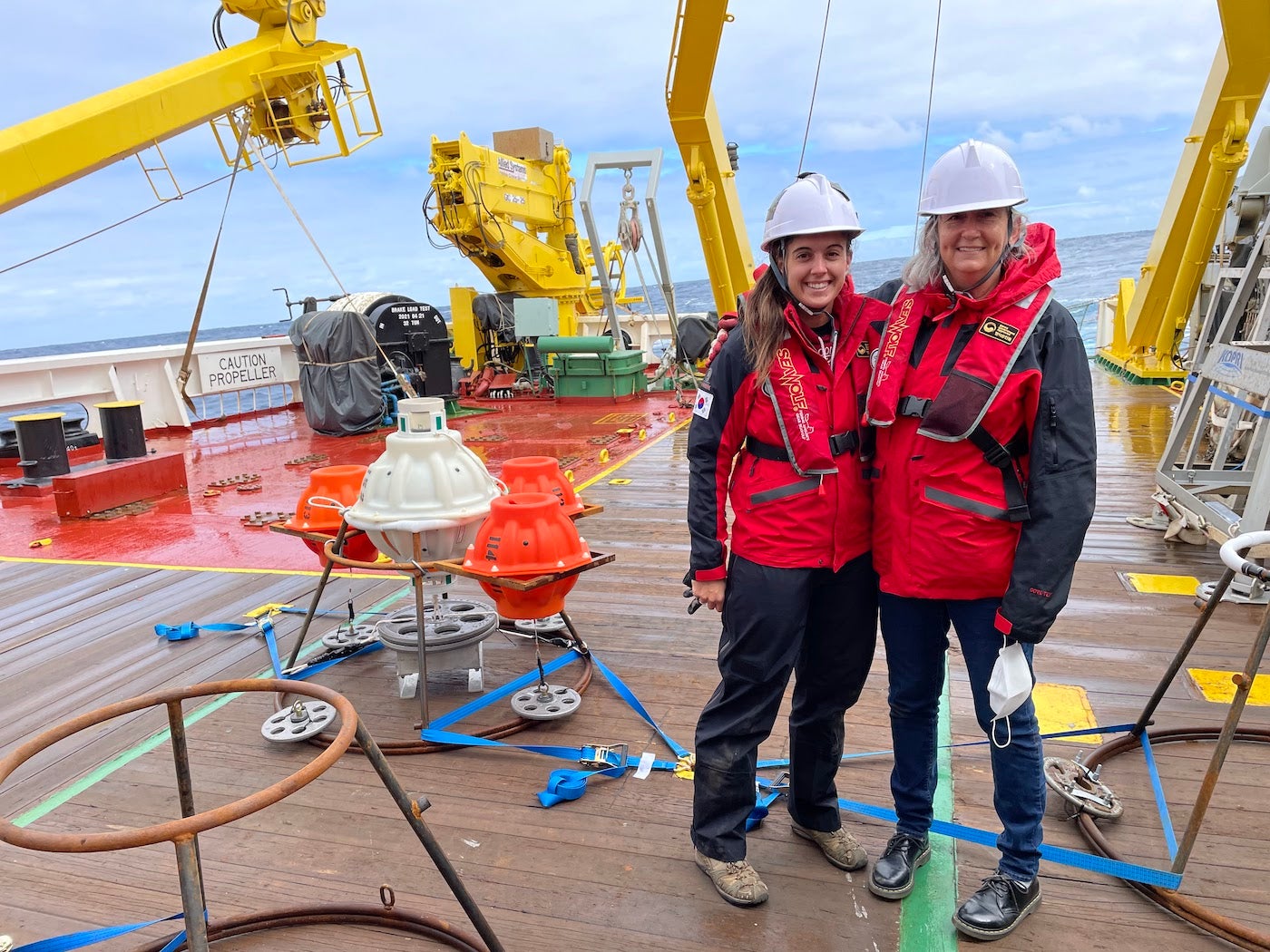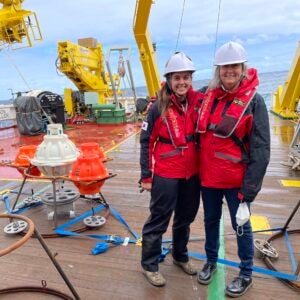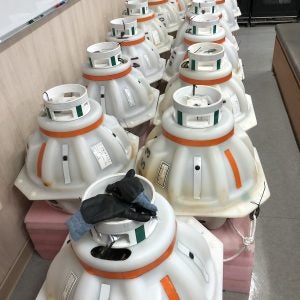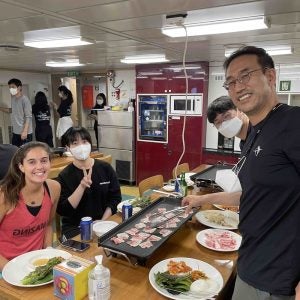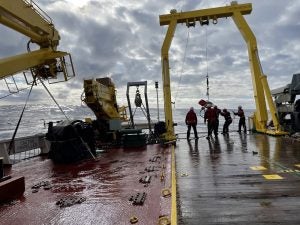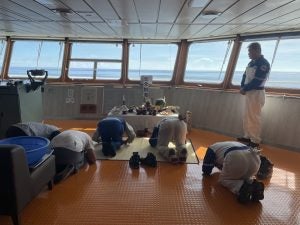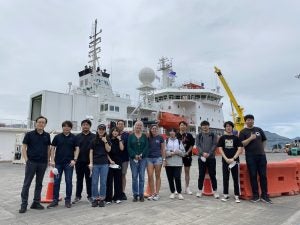February 17, 2022
Written by Ph.D. candidate Diana Fontaine
How far are scientists willing to go for their science?
Recently, URI Graduate School of Oceanography professor Kathleen Donohue and Ph.D. student Ali Johnson had quite a journey to the Antarctic Circumpolar Current (ACC), involving a lengthy time at sea, new scientific instruments, and a complicated journey home because of a rapidly spreading COVID-19 variant.
The Southern Ocean and climate change
As the largest current in the world’s ocean, the ACC transports over 100 million cubic meters of water per second, about 100 times the flow of all the Earth’s rivers combined! Given the scale of the ACC, it is important for global ocean processes. Furthermore, because ACC plays a vital role in bringing heat to the Southern Ocean, understanding its dynamics is critical during this time of rapid climate change.
Donohue and Johnson began their adventure when they joined colleagues from the Korean Polar Research Institute (KOPRI) on a research cruise onboard the Ice Breaker R/V Araon to understand the movement of heat across the ACC. “Only a handful of measurements of heat flux have been made in the ACC, and these measurements have been targeted along its northern edge,” Donohue said.
The goal for this project was to focus on the southern-most edge of the ACC because, according to Donohue, “this truly is the ‘gateway’ to the Southern Ocean—it is the last place where heat can move from the ACC into the Southern Ocean.”
The data collected from this project will help validate ocean models that are trying to predict how the Southern Ocean will respond to climate change.
This U.S.-Korean project is part of a larger initiative called Southern Ocean Long Term Monitoring, which is composed of an interdisciplinary team of biological, chemical and physical oceanographers. Jisoo Park (KOPRI) is the lead investigator and other collaborators included TaeWan Kim (KOPRI) and JaeHun Park (Inha University).
While there was plenty of science happening during the cruise such as as Bongo nets, seismic surveys and aerosol studies, Donohue and Johnson focused on deploying instruments called Current and Pressure recording Inverted Echo Sounders (CPIES) to measure heat flux. These CPIES are instruments that sit on the seafloor in an array and measure near bottom velocities and pressure. Initially, only four KOPRI CPIES were scheduled for deployment, but Donohue together with GSO research professor Randy Watts from URI and colleagues Xiaobiao Xu and Eric Chassignet (Florida State University) were able to secure funding from the U.S. National Science Foundation to bring twelve additional CPIES for the project.
“The CPIES were outfitted with a relatively new piece of technology that allows data shuttles to pop up to the sea surface on a predetermined schedule,” said Donohue.
Once at the sea surface, the data shuttles connect with satellites to transmit data to investigators so they can retrieve it without having to go back to the site to recover the instruments. This technology was developed by the GSO PIES group including Watts and GSO engineer Erran Sousa.
True dedication
Of course, pursuing ocean science during a global pandemic is not easy. For starters, Donohue and Johnson had to depart from South Korea instead of New Zealand because of COVID-19 restrictions. It took three weeks for the group to reach their study region, essentially quadrupling their transit time to the study region for six days of science. “It makes us think, what are we willing to do for six days of science–how long are we going to quarantine for and be on the ship to be able to carry out our research,” Donohue said.
To make matters even more interesting, Donohue and Johnson had almost no internet access. “We could hardly get an email in or out.” said Donohue. “It makes you think about how reliant we are on the internet these days.”
To stay busy during transit, Donohue and Johnson played the card game Rummy—180 games, to be exact. Johnson was the champion of their ongoing competition throughout the cruise. They also took part in ceremonies that brought all of the cruise participants together, such as an equator crossing ceremony on the bridge of the ship.
Although science comes first on research trips, the food onboard would make any foodie jealous. Donohue and Johnson described mealtime as an adventure, and a little present every time. For example, Western lunch on Wednesdays with french fries, salad, burgers and potatoes, Korean barbecue on Saturday nights with a skillet on each table covered in various kinds of meat, and different types of traditional Korean food and Korean fusion throughout the week.
A complicated journey home
After a long trek and a busy time at sea, the ship returned to New Zealand for demobilization. Little did Donohue and Johnson know while they were away, the Biden administration changed the COVID-19 testing requirements for re-entry to the United States due to the Omicron wave. Instead of getting a test within 72 hours prior to arrival to the U.S., they needed to have a test within 24 hours of departure. Unfortunately, New Zealand did not have rapid testing available and PCR tests had a typical turnaround of 48-72 hours.
Thinking they might be stuck in New Zealand, Donohue and Johnson frantically called and emailed anyone they could think of to figure out a solution. “We even walked to the airport to talk to people there and see what they know,” said Johnson. “Luckily our hotel was within walking distance to the airport, and it ultimately led to our solution: the U.S. Antarctic Program.”
Donohue and Johnson spoke with Air New Zealand employees and discovered that people returning to the U.S. from the U.S. Antarctic Program were able to secure tests. GSO Dean Paula Bontempi contacted the program’s director who then secured a nurse to coordinate tests for Donohue and Johnson. “We were extremely grateful for Dean Bontempi’s efforts to get us home for the holidays,” said Johnson.
After all the testing requirement chaos, Donohue and Johnson were relieved to be returning home. “New Zealand was great. Once we had it all sorted out, it was nice to explore the area for a bit,” said Johnson. “It was hard to miss Thanksgiving at home, so I was really glad to be back with family for the Christmas holiday.”
Future plans for the Southern Ocean project include collaborative modelling efforts, and Johnson plans to use some of the data collected on this cruise for her dissertation. “We’re working with a modelling team out of Florida State University and we plan to have the first round of data back by September 2022,” she said.
After a memorable eight weeks together, Donohue and Johnson have built a close bond. “We were still delighted to sit next to each other on the airplane,” Donohue said.
Johnson added, “We still love each other, perhaps even more.”

